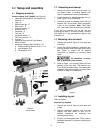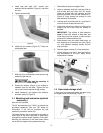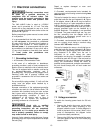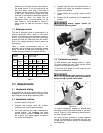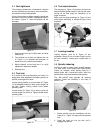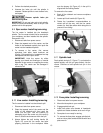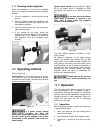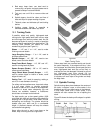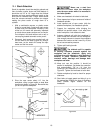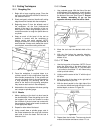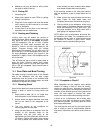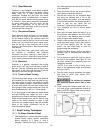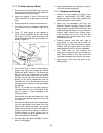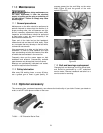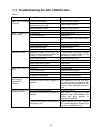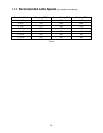
16
10.4 Stock Selection
Stock for spindles should be straight grained and
free of checks, cracks, knots and other defects. It
should be cut 1/8" to 1/4" larger than the finished
diameter and may require additional length so the
ends can be removed later. Larger stock should
have the corners removed to produce an octagon
making the piece easier to rough down to a
cylinder.
1. With a combination square, or plastic center
finder for round stock, locate and mark center
on each end of the workpiece. Accuracy is not
critical on full rounds but extremely important
on stock where square sections are to remain.
Put a dimple in the stock with an awl or nail, or
use a spring-loaded automatic center punch.
2. Extremely hard woods may require kerfs cut
into the ends of the stock (Figure 23) using a
band saw, so the wood will accept the spur
center and the live center.
Figure 23
3. Drive the spur center about 1/4” into the
workpiece, using a wood mallet or dead blow
hammer as shown in Figure 24. Be careful that
you do not split the workpiece.
Figure 24
Never use a steel face
hammer and never drive the workpiece
onto the spur center while it is mounted in
the Lathe spindle.
4. Make sure headstock is locked to lathe bed.
5. Clean tapered end of spur center and inside of
headstock spindle.
6. Insert tapered end of spur center (with the
attached workpiece) into headstock spindle.
7. Support the workpiece while bringing the
tailstock into position about 1-inch away from
end of workpiece. Lock tailstock to bed.
8. Advance tailstock quill with the handwheel in
order to seat the live center into the workpiece.
Use enough pressure to secure the workpiece
between the centers so that it won’t fly off, but
do not use excessive pressure.
9. Tighten quill locking handle.
The tailstock quill is capable
of exerting excessive pressure against the
workpiece and the headstock. Apply only
sufficient force with tailstock to hold workpiece
securely in place. Excessive pressure can
overheat center bearings and damage both
workpiece and lathe.
10. Move tool rest into position. It should be
parallel to workpiece, just below the centerline
and approximately 1/8" to 1/4" from the
corners of the workpiece to be turned, as in
Figure 25. Tighten tool rest base to Lathe bed.
11. Rotate workpiece by hand to check for proper
clearance.
12. Start lathe at lowest speed and bring it up to
the appropriate RPM for the size of workpiece
used. Consult digital readout on the
headstock.
Figure 25



